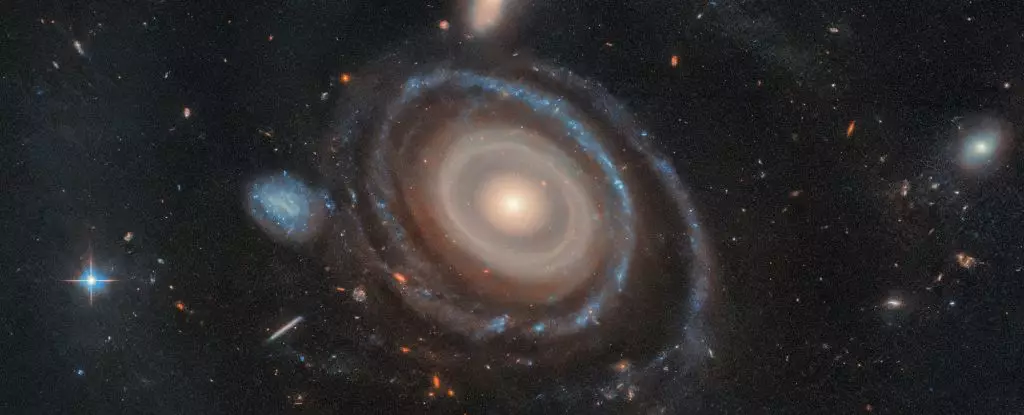The universe is a vast tapestry of celestial bodies, each distinct but governed by common physical laws. Among the myriad of galaxies, the recent discovery of a galaxy located 567 million light-years away has captivated the attention of astronomers. This galaxy, named LEDA 1313424, has garnered the title of the Bullseye Galaxy due to its extraordinary structure characterized by nine concentric rings. This complex formation results from a cataclysmic event: a blue dwarf galaxy’s violent passage through its core. The implications of this discovery extend beyond mere aesthetics, presenting a fascinating chapter in our understanding of galactic interactions and evolution.
Galaxies, while appearing solitary in the vastness of space, are often entangled with each other within the cosmic web. This intricate network of dark matter and gas filaments creates gravitational pulls that lead to unexpected collisions and interactions. The formation of ring galaxies, such as the Bullseye Galaxy, is a rarified event, typically arising from exceedingly specific conditions. Broadly speaking, these collisions can take myriad forms, from peaceful mergers to violent encounters. The latter serves as a conduit for dramatic transformations, reshaping galaxies in ways that challenge existing paradigms of astrophysics.
The structure of the Bullseye Galaxy is particularly intriguing. As astronomer Pieter van Dokkum from Yale University remarks, “We’re catching the Bullseye at a very special moment in time.” This reiterates the temporality surrounding such galactic phenomena and suggests that the Bullseye is showcasing a fleeting state at a stage not often observed. The unique rings serve not only as visual markers but also as indicators of underlying physical processes that engage in star formation and galactic evolution.
Utilizing advanced technology has proved pivotal in studying the Bullseye Galaxy. The Hubble Space Telescope provided initial images that illuminated the galaxy’s intricate features. However, it was the Keck Cosmic Web Imager (KCWI) that unveiled the critical details of the encounter between the Bullseye Galaxy and its smaller counterpart. The proximity of this companion galaxy, located a mere 130,000 kilometers away, reveals a connection that is physically observed through the transfer of gas between the two systems. This is visually expressed as gas tendrils linking both galaxies, a finding that is unprecedented in the study of cosmic interactions.
Imad Pasha, another Yale astronomer, emphasizes the significance of KCWI’s data, noting the clarity with which the gas streaming from the smaller galaxy can be seen. Such observations are key in confirming the hypothesis that the smaller galaxy acted as an impactor, radically transforming the structure of the Bullseye Galaxy.
The concentric rings of the Bullseye Galaxy represent areas of greater density, where galactic materials have converged due to shock waves emanating from the collision. This increased density fuels star formation, leading to an enhanced luminosity that makes the rings shine vividly against the vast darkness of space. The interplay between gas and dust is intricately linked to the evolution of galaxies, as regions with high density often act as nurseries for new stars.
Interestingly, the formation of these rings adheres closely to established theoretical predictions, mimicking the ripple effects observed when a pebble is thrown into a pond. The first two rings expand rapidly, with the subsequent rings taking longer to form. This knowledge not only reinforces existing models but also enriches astronomers’ understanding of the dynamic life cycles of galaxies.
The discovery of the Bullseye Galaxy stands as a testament to the ongoing advancements in astronomical research, signaling an epoch where new findings can reinterpret older theories. As researchers continue to explore the cosmos with cutting-edge telescopes, expectations soar regarding future discoveries that may unveil other ring galaxies hidden within the depths of space.
The revelations gleaned from the Bullseye Galaxy encourage a re-evaluation of how galaxy collisions are perceived. They underscore the complexity of such interactions and serve as a reminder of the universe’s unpredictability. Each new discovery offers a glimpse into the intricate dance of cosmic evolution, inviting exploration into the myriad forms that galaxies can take, ultimately enriching our collective understanding of the universe.


Leave a Reply